This was published 1 year ago
To save the Amazon, a project is making sure cattle farmers earn another living
By Manuela Andreoni
Maracaçumé, Brazil: The residents of Maracaçumé, an impoverished town on the edge of the Amazon rainforest, are mystified by the company that recently bought the biggest cattle farm in the region. How can it possibly make money by planting trees, which executives say they’ll never cut down, on pastureland where cows have been grazing for decades?
“We are killing pasture that a lot of farmers need,” said Josias Araújo, a former cowboy who now works in reforestation, as he stood on a patch of soil he was helping to fertilise. “It’s all strange.”
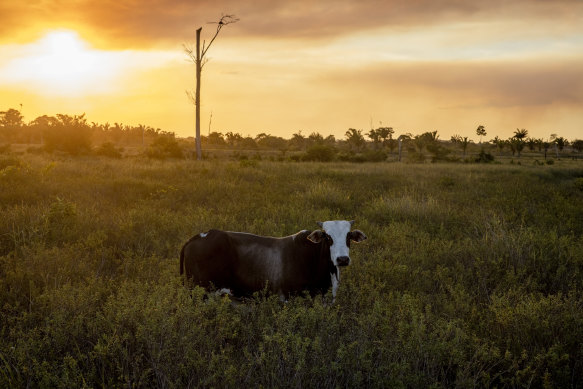
Some cattle on a farm in Maracaçumé, Brazil, have to make room for trees to return.Credit: Victor Moriyama/The New York Times
The new company, which is also Araújo’s new employer, is a forest restoration business called Re.green. Its aim, along with a handful of other companies, is to create a whole new industry that can make standing trees, which store planet-warming carbon, more lucrative than the world’s biggest driver of deforestation: cattle raising.
It’s the holy grail of the forest economy. And now it might be within reach.
The stakes are high. About one-fifth of the great rainforest is already gone. And scientists warn that rising global temperatures could push the entire ecosystem, a trove of biodiversity and a crucial regulator of the world’s climate, to collapse in the coming decades unless deforestation is halted and an area the size of Germany is restored.
Re.green plans to restore native trees in deforested areas and sell credits that correspond to the carbon they lock away. Those trees will be protected, not logged. Then, businesses will use those credits to offset their own greenhouse gases in emissions accounting.
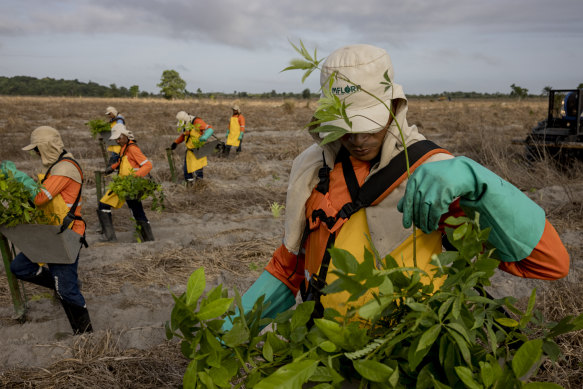
Forest restoration workers planting native Amazonian seedlings on degraded pastureland in Mãe do Rio, Brazil.Credit: Victor Moriyama/The New York Times
The bet hinges on the success of a system that’s being built from scratch and comes with some big challenges. Measuring the carbon held in trees and soil is complex. And many conservationists worry that carbon credits could easily be abused by companies that want to appear environmentally conscious while sticking with fossil fuels.
Still, reforestation projects have created a buzz in the northern Amazon, where companies are rushing to buy up big plots of land with restoration potential.
“You know that people who handle cattle don’t care much about this reforestation stuff,” said Anderson Pina Farias, a farmer whose land is almost completely deforested. But, he added, “if selling carbon is better than ranching, we can change businesses.”
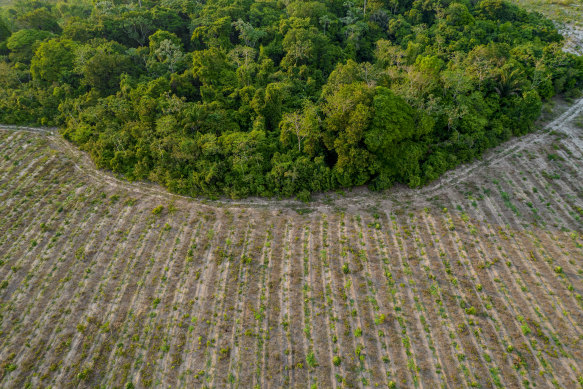
Tree seedlings on a former pasture that borders rainforest in Mãe do Rio, Brazil.Credit: Victor Moriyama/The New York Times
Challenging an Empire
A backlash from nature seems to be helping the restoration companies win hearts and minds in a region where cattle culture runs deep.
Jose Villeigagnon Rabelo, the mayor of Mãe do Rio, a city in the north-eastern part of the Amazon, is worried. A brutal drought fuelled by climate change and deforestation has recently dried out much of the grass that farmers there use as feed. And after decades of pounding by hooves, millions of hectares across the region have become so degraded, they can’t nourish much of anything.
“The cattle are starving,” Rabelo said sitting in his office, with wooden paneling and benches made of angelim-vermelho, a tree that’s become hard to find in the region. “We’ve never had a summer like this.”
The crisis has prompted farmers to dedicate bigger and bigger parts of their land to feed ever-shrinking numbers of cattle. Now fewer than half of the cattle farms registered with the city have any cattle on them.
But around a year ago, a restoration company called Mombak started a 3000-hectare project on one of the region’s biggest farms. Rabelo said he was hopeful the new industry would offer the community a lifeline.
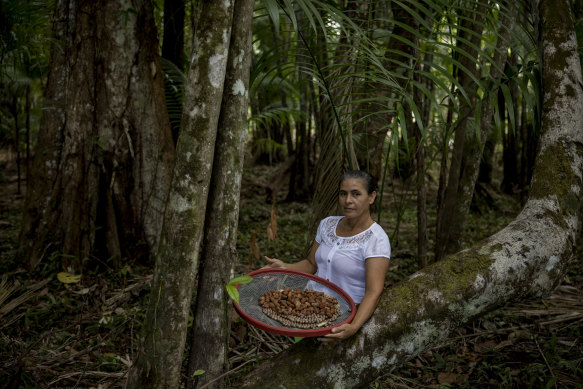
A seed collector trained by Re.green, a forest restoration company, in Maracaçumé, Brazil.Credit: Victor Moriyama/The New York Times
The idea is simple and used elsewhere: carbon credits – a credit for each tonne of carbon pulled out of the atmosphere by the trees that can be sold to companies wanting to compensate for their own pollution.
Environmental disruptions, combined with growing interest in carbon credits, have created an opening to challenge the beef empire’s hold on vast stretches of the rainforest, experts say. According to a 2023 report by BloombergNEF, carbon markets could be valued at $US1 trillion by 2037, double what the global beef market is worth now.
Growing a large, biodiverse forest on degraded land can cost tens of millions of dollars. For years, forestry projects had to rely on multiple revenue streams, including sustainable timber harvesting, to restore soil and grow different types of natives trees.
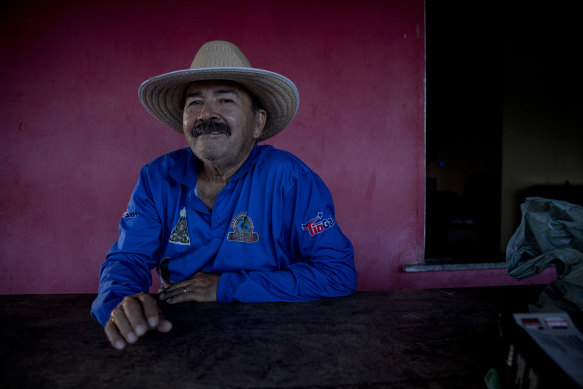
Farmer Djalma Soares has always worked cattle but admits bringing the forest back to life is “beautiful”.Credit: Victor Moriyama/The New York Times
But businesses looking to burnish their climate credentials are increasingly willing to spend more to fund projects they deem to be high-quality. It’s why companies like Mombak and Re.green are now developing a business model that relies almost solely on carbon credits, with little or no logging.
Microsoft has bought a major project from Mombak, and Re.green said it expected to announce buyers soon. The two companies have raised some $US200 million ($304 million) from investors – including large pension funds, the Brazilian Development Bank and global asset managers – to reforest hundreds of thousands of hectares by the end of the decade.
“Scaling all of the other carbon-removal sectors, it’s just going to move too slow,” said Brian Marrs, Microsoft’s senior director of energy and carbon. “I don’t think there’s a solution to carbon removal without global forestry included.”
Part of the strategy of companies like Mombak and Re.green is to help farmers improve land and intensify cattle ranching in some degraded areas while restoring forests on others. On average, Amazon pastures support one animal on every 2 acres (0.8 hectares). That could rise to three animals with little investment, researchers say.
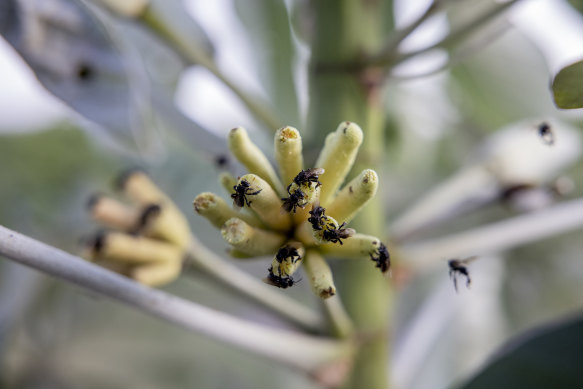
Insect pollinators return to a plant of the Mombak project in Mãe do Rio.Credit: Victor Moriyama/The New York Times
Most projects employ a few dozen local people to plant trees, fertilise the soil and stand lookout for fires. The companies are also funding and training local businesses to provide much-needed native seeds and seedlings.
In some projects, as the forests grow, local communities can also make a living from collecting and processing Brazil nuts, andiroba oil, acai and other forest products they can sell to food, beauty and pharmaceutical companies.
When a standing forest becomes an answer to people’s range of needs, that becomes a powerful reason for communities to protect it, said Luiza Maia de Castro, an economist who is managing community relations for Re.green. Right now, razing trees is a perfectly acceptable livelihood in most of the Amazon.
“To break that cycle,” she said, “you have to change how people make a living.”
‘Real questions’ about a new model
The efforts still face big challenges. The supply of seeds for native trees is a bottleneck, and finding farms to buy in regions where land tenure is chaotic can take months of research.
Perhaps more important, the trajectory of carbon credit prices depends on whether the world can agree on what a high-quality credit looks like. The carbon markets have been repeatedly rattled by academic and media investigations that revealed dozens of projects had overstated their emissions impact, for instance, by “protecting” forests that were never in danger of being cut down.
But reforestation projects store carbon by growing trees on degraded land, a more straightforward system.
Some experts caution that displaced cattle could simply continue to drive deforestation elsewhere and that forest fires could erase the benefits of trees that took decades to grow.
“It sounds like carbon finance can make a difference,” said Barbara Haya, the director of the Berkeley Carbon Trading Project, which has investigated a number of carbon forestry projects. But she said there were also real questions about accounting methods.
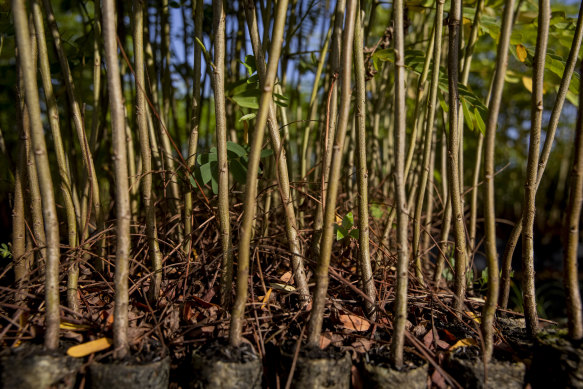
Young trees ready for planting at the Re.green farm in Maracaçumé.Credit: Victor Moriyama/The New York Times
And, she added, “it’s problematic to trade forest carbon for fossil fuel emissions”. That’s partly because buying carbon credits might prove less costly than transitioning a business away from dirty sources of energy, the thing that scientists say the world must ultimately do to avoid the worst effects of climate change.
The companies say they have addressed concerns by setting up firefighting teams, making sure their projects don’t affect cattle supply and adopting a methodology that allows for changing circumstances like new government land policies.
And remaking a forest isn’t only about the carbon math. It takes a lot more than planting trees. To get it right, scientists working in restoration have to study how each plant fits into a complex ecosystem.
Walking in the forest that remains in Re.green’s farm in Maracaçumé, Ricardo Rodrigues, University of São Paulo professor and a Re.green co-founder, didn’t stop by the samaúma tree, an Amazonian giant that can live hundreds of years and grow more than 60 metres tall, or by the peroba, which is prized in the timber industry.
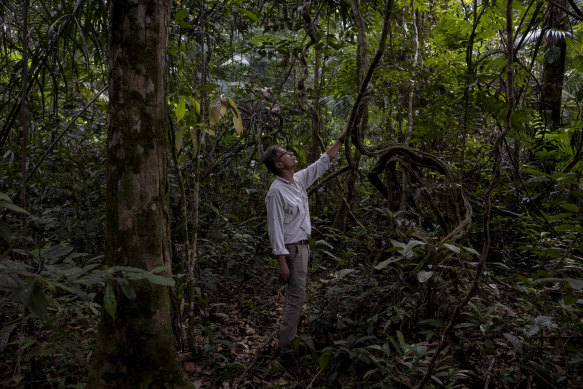
Ricardo Rodrigues, a professor and a co-founder of the forest restoration company Re.green, shows a monkey ladder vine in Maracaçumé, Brazil.Credit: Victor Moriyama/The New York Times
Instead, he grabbed a vine called a monkey ladder, which was about three metres long and perhaps 30cm in diameter, that was hanging from a branch.
“For it to grow to this size, it takes decades,” he said. But the forest needs it, he added because it holds a lot of water, producing flowers and fruit during drier seasons. “It maintains pollinators when trees can’t.”
Creating the conditions for vines, bromeliads and orchids to grow is a part the challenge, too, he said. It’s how you make sure the forest will remain a forest after humans stop helping it along.
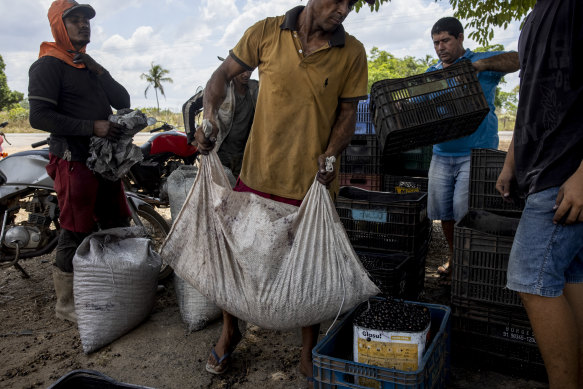
Workers unload açaí fruit at a farm run by Re.green, a forest restoration company, in Maracaçumé, Brazil.Credit: (Victor Moriyama/The New York Times
Right now, the idea is to get humans and nature to work together. Techniques vary, depending on how far each parcel of land is from the existing forests. The nearest new plots benefit from the forest’s regenerative powers.
In Mãe do Rio, reforestation workers have been planting 1000 seedlings a day, working alongside tractors that make trenches on the soil. Drones are documenting their progress.
Six months after the first round of planting, the team was ready to measure the 44 trees in one sample plot. Luiz Carlos Batista Lobato, a botanist who specialises in tree censuses, walked across the plot to document three trees that had died, many that were taller than him and one that was more than five centimetres thick.
In a few years, Batista Lobato said, monkeys and armadillos would come to eat the fruits of different trees, and birds would feast on the açaí berries, dispersing their seeds as they move around the forest.
“That’s the cycle,” he said.
Watching the trees start to grow helped to dispel some of the scepticism that farmers across the region still have. Back in Maracaçumé, Djalma Soares, a farmer who works on land next to the Re.green project, said that although he still loved his cattle, he couldn’t deny that the idea of bringing the forest back to life was “beautiful”.
Soares said he never had the privilege of studying all the other things he could do with his farm beyond raising cattle. But still, he feels the unrelenting heat. Seeing his neighbours work to address that, he said, was inspiring.
“We end up feeling like following the same path,” he added as he watched the sun set on a vast pasture. “We see that it’s the future.”
This article originally appeared in The New York Times.